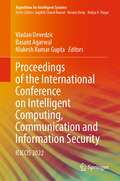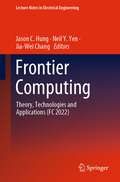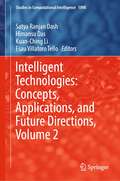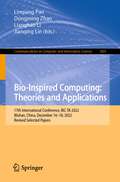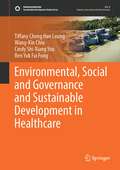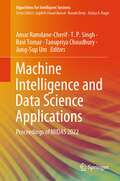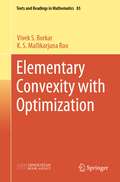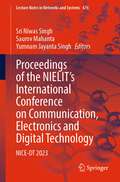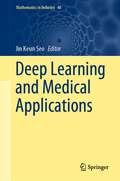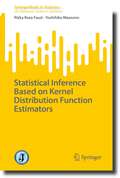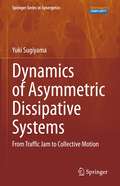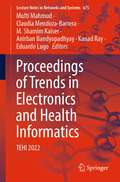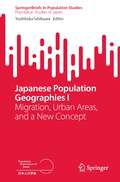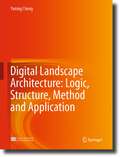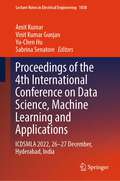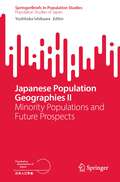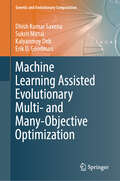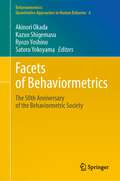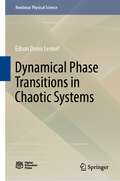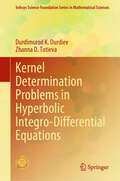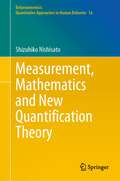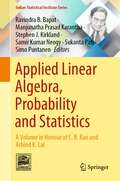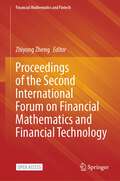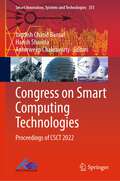- Table View
- List View
Proceedings of the International Conference on Intelligent Computing, Communication and Information Security: ICICCIS 2022 (Algorithms for Intelligent Systems)
by Vladan Devedzic Basant Agarwal Mukesh Kumar GuptaThis book contains high quality research papers accepted and presented at the International Conference on Intelligent Computing, Communication and Information Security (ICICCIS 2022), organized by Swami Keshvanand Institute of Technology, Management & Gramothan (SKIT), Jaipur, India during 25-26, November 2022. It presents the solutions of issues and challenges in intelligent computing, communication and information security domains. This book provides a background to problem domains, considering the progress so far, assessing the potential of such approaches, and exploring possible future directions as a single readily accessible source.
Frontier Computing: Theory, Technologies And Applications Fc 2016 (Lecture Notes In Electrical Engineering Ser. #422)
by Jason C. Hung Neil Y. Yen Jia-Wei ChangIntelligent Technologies: Concepts, Applications, and Future Directions, Volume 2 (Studies in Computational Intelligence #1098)
by Satya Ranjan Dash Himansu Das Kuan-Ching Li Esau Villatoro TelloThis book discusses automated computing systems which are mostly powered by intelligent technologies like artificial intelligence, machine learning, image recognition, speech processing, cloud computing, etc., to perform complex automated tasks which are not possible by traditional computing systems. The chapters are extended version of research works presented at second PhD Research Symposium in various advanced technologies used in the field of computer science. This book provides an opportunity for the researchers to get ideas regarding the ongoing works that help them in formulating problems of their interest. The academicians can also be benefited to know about the current research trends that smooth the way to guide their students to carry out research work in the proper direction. The industry people will be also facilitated to know about the current advances in research work and materialize the research work into industrial applications.
Bio-Inspired Computing: 14th International Conference, Bic-ta 2019, Zhengzhou, China, November 22-25, 2019, Revised Selected Papers, Part Ii (Communications In Computer And Information Science Ser. #1160)
by Linqiang Pan Dongming Zhao Lianghao Li Jianqing LinEnvironmental, Social and Governance and Sustainable Development in Healthcare (Sustainable Development Goals Series)
by Tiffany Cheng Leung Wang-Kin Chiu Cindy Shi-Xiang You Ben Yuk FongThis book applies environmental, social and governance (ESG) to issues of sustainable development in healthcare. ESG reporting has been widely used for some time in the business industry to show the economic, social and environmental responsibilities of companies that aim to achieve superior ESG performance for lower risk, more accountability and transparency. Moreover, public-listed companies in healthcare have been growing in significant numbers in recent years. The application or practice of ESG in healthcare has become a growing trend for these large organisations looking to demonstrate their strengths in areas of financing, operations, sustainability and social responsibilities. Such an approach is essential not only for the long-term development of the companies but also for services delivered by healthcare practitioners. Equally, the implications to Sustainable Development Goal (SDG) 3 is relevant to healthcare worldwide with a growing ageing population, which has led to a great burden of care in many countries, particularly in the public sector. The potential development and expansion in private healthcare services, accelerated by technology advancement, has demanded a new paradigm in the healthcare industry, particularly in business, service delivery and policy. The book examines this paradigm through health in all policies, ESG and SDG 3 objectives, research, training and practice. It is relevant to graduate students and scholars working in areas relating to health, business and the SDGs and is also useful to policymakers and practitioners in healthcare.
Machine Intelligence and Data Science Applications: Proceedings of MIDAS 2022 (Algorithms for Intelligent Systems)
by Amar Ramdane-Cherif T. P. Singh Ravi Tomar Tanupriya Choudhury Jung-Sup UmThis book is a compilation of peer-reviewed papers presented at the International Conference on Machine Intelligence and Data Science Applications (MIDAS 2022), held on October 28 and 29, 2022, at the University of Versailles—Paris-Saclay, France. The book covers applications in various fields like data science, machine intelligence, image processing, natural language processing, computer vision, sentiment analysis, and speech and gesture analysis. It also includes interdisciplinary applications like legal, healthcare, smart society, cyber-physical system, and smart agriculture. The book is a good reference for computer science engineers, lecturers/researchers in the machine intelligence discipline, and engineering graduates.
Elementary Convexity with Optimization (Texts and Readings in Mathematics #83)
by Vivek S. Borkar K. S. RaoThis book develops the concepts of fundamental convex analysis and optimization by using advanced calculus and real analysis. Brief accounts of advanced calculus and real analysis are included within the book. The emphasis is on building a geometric intuition for the subject, which is aided further by supporting figures. Two distinguishing features of this book are the use of elementary alternative proofs of many results and an eclectic collection of useful concepts from optimization and convexity often needed by researchers in optimization, game theory, control theory, and mathematical economics. A full chapter on optimization algorithms gives an overview of the field, touching upon many current themes. The book is useful to advanced undergraduate and graduate students as well as researchers in the fields mentioned above and in various engineering disciplines.
Proceedings of the NIELIT's International Conference on Communication, Electronics and Digital Technology: NICE-DT 2023 (Lecture Notes in Networks and Systems #676)
by Sri Niwas Singh Saurov Mahanta Yumnam Jayanta SinghThe book presents selected papers from NIELIT's International Conference on Communication, Electronics and Digital Technology (NICE-DT 2023) held during February 10–11, 2023, in New Delhi, India. The book covers state-of-the-art research insights on artificial intelligence, machine learning, big data, data analytics, cyber security and forensic, network and mobile security, advance computing, cloud computing, quantum computing, VLSI and semiconductors, electronics system, Internet of Things, robotics and automations, blockchain and software technology, digital technologies for future, assistive technology for divyangjan (people with disabilities) and Strategy for Digital Skilling for building a global Future Ready workforce.
Deep Learning and Medical Applications (Mathematics in Industry #40)
by Jin Keun SeoOver the past 40 years, diagnostic medical imaging has undergone remarkable advancements in CT, MRI, and ultrasound technology. Today, the field is experiencing a major paradigm shift, thanks to significant and rapid progress in deep learning techniques. As a result, numerous innovative AI-based programs have been developed to improve image quality and enhance clinical workflows, leading to more efficient and accurate diagnoses.AI advancements of medical imaging not only address existing unsolved problems but also present new and complex challenges. Solutions to these challenges can improve image quality and reveal new information currently obscured by noise, artifacts, or other signals. Holistic insight is the key to solving these challenges. Such insight may lead to a creative solution only when it is based on a thorough understanding of existing methods and unmet demands.This book focuses on advanced topics in medical imaging modalities, including CT and ultrasound, with the aim of providing practical applications in the healthcare industry. It strikes a balance between mathematical theory, numerical practice, and clinical applications, offering comprehensive coverage from basic to advanced levels of mathematical theories, deep learning techniques, and algorithm implementation details. Moreover, it provides in-depth insights into the latest advancements in dental cone-beam CT, fetal ultrasound, and bioimpedance, making it an essential resource for professionals seeking to stay up-to-date with the latest developments in the field of medical imaging.
Statistical Inference Based on Kernel Distribution Function Estimators (SpringerBriefs in Statistics)
by Rizky Reza Fauzi Yoshihiko MaesonoThis book presents a study of statistical inferences based on the kernel-type estimators of distribution functions. The inferences involve matters such as quantile estimation, nonparametric tests, and mean residual life expectation, to name just some. Convergence rates for the kernel estimators of density functions are slower than ordinary parametric estimators, which have root-n consistency. If the appropriate kernel function is used, the kernel estimators of the distribution functions recover the root-n consistency, and the inferences based on kernel distribution estimators have root-n consistency. Further, the kernel-type estimator produces smooth estimation results. The estimators based on the empirical distribution function have discrete distribution, and the normal approximation cannot be improved—that is, the validity of the Edgeworth expansion cannot be proved. If the support of the population density function is bounded, there is a boundary problem, namely the estimator does not have consistency near the boundary. The book also contains a study of the mean squared errors of the estimators and the Edgeworth expansion for quantile estimators.
Dynamics of Asymmetric Dissipative Systems: From Traffic Jam to Collective Motion (Springer Series in Synergetics)
by Yuki SugiyamaThis book provides the dynamics of non-equilibrium dissipative systems with asymmetric interactions (Asymmetric Dissipative System; ADS). Asymmetric interaction breaks "the law of action and reaction" in mechanics, and results in non-conservation of the total momentum and energy. In such many-particle systems, the inflow of energy is provided and the energy flows out as dissipation. The emergences of non-trivial macroscopic phenomena occur in the non-equilibrium energy balance owing to the effect of collective motions as phase transitions and bifurcations. ADS are applied to the systems of self-driven interacting particles such as traffic and granular flows, pedestrians and evacuations, and collective movement of living systems. The fundamental aspects of dynamics in ADS are completely presented by a minimal mathematical model, the Optimal Velocity (OV) Model. Using that model, the basics of mathematical and physical mechanisms of ADS are described analytically with exact results. The application of 1-dimensional motions is presented for traffic jam formation. The mathematical theory is compared with empirical data of experiments and observations on highways. In 2-dimensional motion pattern formations of granular media, pedestrians, and group formations of organisms are described. The common characteristics of emerged moving objects are a variety of patterns, flexible deformations, and rapid response against stimulus. Self-organization and adaptation in group formations and control of group motions are shown in examples. Another OV Model formulated by a delay differential equation is provided with exact solutions using elliptic functions. The relations to soliton systems are described. Moreover, several topics in ADS are presented such as the similarity between the spatiotemporal patterns, violation of fluctuation dissipation relation, and a thermodynamic function for governing the phase transition in non-equilibrium stationary states.
Proceedings of Trends in Electronics and Health Informatics: TEHI 2022 (Lecture Notes in Networks and Systems #675)
by Mufti Mahmud Claudia Mendoza-Barrera M. Shamim Kaiser Anirban Bandyopadhyay Kanad Ray Eduardo LugoThis book includes selected peer-reviewed papers presented at the International Conference on Trends in Electronics and Health Informatics (TEHI 2022), held at University of Puebla, Puebla, México, during December 7–9, 2022. The book is broadly divided into five sections—artificial intelligence and soft computing, healthcare informatics, Internet of things and data analytics, electronics, and communications.
Japanese Population Geographies I: Migration, Urban Areas, and a New Concept (SpringerBriefs in Population Studies)
by Yoshitaka IshikawaThis is the first anthology that conveys in detail the actual situation of population geographies in Japan, a country facing some of the world's most serious demographic trends such as low fertility, population aging, and depopulation. The anthology consists of two volumes with the common title Japanese Population Geographies. All of the included entries are based on original Japanese papers written by leading geographers and published within the past few years, useful for understanding Japan’s current population geographies. The first volume analyzes the postwar transition of internal migration, examining the structural changes of population in urban areas, and proposes a new measure different from the traditional resident population. This volume also presents an investigation of the retirement migration of baby boomers as well as displacement migration due to the 2011 Great East Japan Earthquake. The second volume’s contents examine the residential choices of minority populations such as foreign residents and sexual minorities. It also discusses future prospects associated with mono-polar concentration into Tokyo, regional forecasting using population projections based on small-area units, and the importance of a politico–economic perspective in the future research. Taken as a whole, this anthology offers the following two significant contributions. First, the excellent achievements obtained in Japan, which is experiencing serious demographic trends, reflect key developments within the context of the world's population geography. The second contribution is that the book brings the latest insights and important policy implications to countries that are facing various issues associated with decreasing fertility, aging population, and declining population.
Digital Landscape Architecture: Logic, Structure, Method and Application
by Yuning ChengClosely related to the frontier research field of “digital technology”, this book reshapes the planning and design process of landscape architecture from theoretical and practical levels. It gives a full-scale discussion to the logic, structure, method, and application of digital landscape architecture, leading this field to a new era of perception-quantification research mode. Readers will get a comprehensive understanding of digital landscape architecture, know about multiple digital methods for landscape planning and design, and learn a lot of practical projects with digital technology. And it will inspire the readers to think about new patterns and approaches to landscape planning, rather than traditional ways. This book is organized under a clear logic, which helps the readers easily get the core of the work. A lot of logic diagrams showing between the theoretical paragraphs highly summarize the key points of the book, providing a better readability and acceptability. This book also contains many detailed drawings and graphics for the project cases, which gives a good demonstration of how digital methods could be applied in practice.
Proceedings of the 4th International Conference on Data Science, Machine Learning and Applications: ICDSMLA 2022, 26–27 December, Hyderabad, India (Lecture Notes in Electrical Engineering #1038)
by Amit Kumar Vinit Kumar Gunjan Yu-Chen Hu Sabrina SenatoreThis book includes peer reviewed articles from the 4th International Conference on Data Science, Machine Learning and Applications, 2022, held at the Hyderabad Institute of Technology & Management on 26-27th December, India. ICDSMLA is one of the most prestigious conferences conceptualized in the field of Data Science & Machine Learning offering in-depth information on the latest developments in Artificial Intelligence, Machine Learning, Soft Computing, Human Computer Interaction, and various data science & machine learning applications. It provides a platform for academicians, scientists, researchers and professionals around the world to showcase broad range of perspectives, practices, and technical expertise in these fields. It offers participants the opportunity to stay informed about the latest developments in data science and machine learning.
Japanese Population Geographies II: Minority Populations and Future Prospects (SpringerBriefs in Population Studies)
by Yoshitaka IshikawaThis is the first anthology that conveys in detail the actual situation of population geographies in Japan, a country facing some of the world's most serious demographic trends such as low fertility, population aging, and depopulation. The anthology consists of two volumes with the common title Japanese Population Geographies. All of the included entries are based on original Japanese papers written by leading geographers and published within the past few years, useful for understanding Japan’s current population geographies. The first volume analyzes the postwar transition of internal migration, examining the structural changes of population in urban areas, and proposes a new measure different from the traditional resident population. This volume also presents an investigation of the retirement migration of baby boomers as well as displacement migration due to the 2011 Great East Japan Earthquake. The second volume’s contents examine the residential choices of minority populations such as foreign residents and sexual minorities. It also discusses future prospects associated with mono-polar concentration into Tokyo, regional forecasting using population projections based on small-area units, and the importance of a politico–economic perspective in future research. Taken as a whole, this anthology offers the following two significant contributions. First, the excellent achievements obtained in Japan, which is experiencing serious demographic trends, reflect key developments within the context of the world's population geography. The second contribution is that the publication brings the latest insights and important policy implications to countries that are facing various issues associated with decreasing fertility, aging population, and declining population.
Machine Learning Assisted Evolutionary Multi- and Many- Objective Optimization (Genetic and Evolutionary Computation)
by Dhish Kumar Saxena Sukrit Mittal Kalyanmoy Deb Erik D. GoodmanThis book focuses on machine learning (ML) assisted evolutionary multi- and many-objective optimization (EMâO). EMâO algorithms, namely EMâOAs, iteratively evolve a set of solutions towards a good Pareto Front approximation. The availability of multiple solution sets over successive generations makes EMâOAs amenable to application of ML for different pursuits. Recognizing the immense potential for ML-based enhancements in the EMâO domain, this book intends to serve as an exclusive resource for both domain novices and the experienced researchers and practitioners. To achieve this goal, the book first covers the foundations of optimization, including problem and algorithm types. Then, well-structured chapters present some of the key studies on ML-based enhancements in the EMâO domain, systematically addressing important aspects. These include learning to understand the problem structure, converge better, diversify better, simultaneously converge and diversify better, and analyze the Pareto Front. In doing so, this book broadly summarizes the literature, beginning with foundational work on innovization (2003) and objective reduction (2006), and extending to the most recently proposed innovized progress operators (2021-23). It also highlights the utility of ML interventions in the search, post-optimality, and decision-making phases pertaining to the use of EMâOAs. Finally, this book shares insightful perspectives on the future potential for ML based enhancements in the EMâOA domain.To aid readers, the book includes working codes for the developed algorithms. This book will not only strengthen this emergent theme but also encourage ML researchers to develop more efficient and scalable methods that cater to the requirements of the EMâOA domain. It serves as an inspiration for further research and applications at the synergistic intersection of EMâOA and ML domains.
Facets of Behaviormetrics: The 50th Anniversary of the Behaviormetric Society (Behaviormetrics: Quantitative Approaches to Human Behavior #4)
by Akinori Okada Kazuo Shigemasu Ryozo Yoshino Satoru YokoyamaThis edited book is the first one written in English that deals comprehensively with behavior metrics. The term “behaviormetrics” comprehends the research including all sorts of quantitative approaches to disclose human behavior. Researchers in behavior metrics have developed, extended, and improved methods such as multivariate statistical analysis, survey methods, cluster analysis, machine learning, multidimensional scaling, corresponding analysis or quantification theory, network analysis, clustering, factor analysis, test theory, and related factors. In the spirit of behavior metrics, researchers applied these methods to data obtained by surveys, experiments, or websites from a diverse range of fields. The purpose of this book is twofold. One is to represent studies that display how the basic elements of behavior metrics have developed into present-day behavior metrics. The other is to represent studies performed mainly by those who would like to pioneer new fields of behavior metrics and studies that display elements of future behavior metrics. These studies consist of various characteristics such as those dealing with theoretical or conceptual subjects, the algorithm, the model, the method, and the application to a wide variety of fields. This book helps readers to understand the present and future of behavior metrics.
Dynamical Phase Transitions in Chaotic Systems (Nonlinear Physical Science)
by Edson Denis LeonelThis book discusses some scaling properties and characterizes two-phase transitions for chaotic dynamics in nonlinear systems described by mappings. The chaotic dynamics is determined by the unpredictability of the time evolution of two very close initial conditions in the phase space. It yields in an exponential divergence from each other as time passes. The chaotic diffusion is investigated, leading to a scaling invariance, a characteristic of a continuous phase transition. Two different types of transitions are considered in the book. One of them considers a transition from integrability to non-integrability observed in a two-dimensional, nonlinear, and area-preserving mapping, hence a conservative dynamics, in the variables action and angle. The other transition considers too the dynamics given by the use of nonlinear mappings and describes a suppression of the unlimited chaotic diffusion for a dissipative standard mapping and an equivalent transition in the suppression of Fermi acceleration in time-dependent billiards. This book allows the readers to understand some of the applicability of scaling theory to phase transitions and other critical dynamics commonly observed in nonlinear systems. That includes a transition from integrability to non-integrability and a transition from limited to unlimited diffusion, and that may also be applied to diffusion in energy, hence in Fermi acceleration. The latter is a hot topic investigated in billiard dynamics that led to many important publications in the last few years. It is a good reference book for senior- or graduate-level students or researchers in dynamical systems and control engineering, mathematics, physics, mechanical and electrical engineering.
Bioaerosol Characterisation, Transportation and Transmission: Fundamental, Modelling and Application
by Yihuan Yan Jiyuan TuThis book aims to predict and model the transport of bioaerosols, identify their transmission characteristics, and assess occupants’ infection risks. Although existing epidemiological books provide fundamental infection rate of existing diseases, the ability of predicting emerging disease transmission in the air and assessing occupants’ infection risks to the bioaerosols is significantly lacking. This book is considered as a professional book that provides in-depth discussion of the aforementioned issues and provides potential approaches to solve these issues would be highly demanded by readers in this emerging research field. This book offers essential and systematic analysis on the fate of bioaerosols from their release in the air to the final destination in human’s respiratory systems through direct 3D visualizations techniques. It also provides quantifiable method to assess each occupant’s infection risks to the infectious bioaerosols in indoor environments. The readers will gain essential fundamental characteristics of bioaerosols (active time, viability, etc.) and will gain the advanced skills on how to integrate these properties into numerical modeling and assess the occupants’ exposure risks.
Kernel Determination Problems in Hyperbolic Integro-Differential Equations (Infosys Science Foundation Series)
by Durdimurod K. Durdiev Zhanna D. TotievaThis book studies the construction methods for solving one-dimensional and multidimensional inverse dynamical problems for hyperbolic equations with memory. The theorems of uniqueness, stability and existence of solutions of these inverse problems are obtained. This book discusses the processes, by using generalized solutions, the spread of elastic or electromagnetic waves arising from sources of the type of pulsed directional “impacts” or “explosions”. This book presents new results in the study of local and global solvability of kernel determination problems for a half-space. It describes the problems of reconstructing the coefficients of differential equations and the convolution kernel of hyperbolic integro-differential equations by the method of Dirichlet-to-Neumann. The book will be useful for researchers and students specializing in the field of inverse problems of mathematical physics.
Measurement, Mathematics and New Quantification Theory (Behaviormetrics: Quantitative Approaches to Human Behavior #16)
by Shizuhiko NishisatoThe purpose of this book is to thoroughly prepare diverse areas of researchers in quantification theory. As is well known, quantification theory has attracted the attention of a countless number of researchers, some mathematically oriented and others not, but all of them are experts in their own disciplines. Quantifying non-quantitative (qualitative) data requires a variety of mathematical and statistical strategies, some of which are quite complicated. Unlike many books on quantification theory, the current book places more emphasis on preliminary requisites of mathematical tools than on details of quantification theory. As such, the book is primarily intended for readers whose specialty is outside mathematical sciences. The book was designed to offer non-mathematicians a variety of mathematical tools used in quantification theory in simple terms. Once all the preliminaries are fully discussed, quantification theory is then introduced in the last section as a simple application of those mathematical procedures fully discussed so far. The book opens up further frontiers of quantification theory as simple applications of basic mathematics.
Applied Linear Algebra, Probability and Statistics: A Volume in Honour of C. R. Rao and Arbind K. Lal (Indian Statistical Institute Series)
by Ravindra B. Bapat Manjunatha Prasad Karantha Stephen J. Kirkland Samir Kumar Neogy Sukanta Pati Simo PuntanenThis book focuses on research in linear algebra, statistics, matrices, graphs and their applications. Many chapters in the book feature new findings due to applications of matrix and graph methods. The book also discusses rediscoveries of the subject by using new methods. Dedicated to Prof. Calyampudi Radhakrishna Rao (C.R. Rao) who has completed 100 years of legendary life and continues to inspire us all and Prof. Arbind K. Lal who has sadly departed us too early, it has contributions from collaborators, students, colleagues and admirers of Professors Rao and Lal. With many chapters on generalized inverses, matrix analysis, matrices and graphs, applied probability and statistics, and the history of ancient mathematics, this book offers a diverse array of mathematical results, techniques and applications. The book promises to be especially rewarding for readers with an interest in the focus areas of applied linear algebra, probability and statistics.
Proceedings of the Second International Forum on Financial Mathematics and Financial Technology (Financial Mathematics and Fintech)
by Zhiyong ZhengThis open access book is the documentary of the Second International Forum on Financial Mathematics and Financial Technology, with focus on selected aspects of the current and upcoming trends in FinTech. In detail, the included scientific papers cover financial mathematics and FinTech, presenting the innovative mathematical models and state-of-the-art technologies such as deep learning, with the aim to improve the financial analysis and decision-making and enhance the quality of financial services and risk control. The variety of the papers delivers added value for both scholars and practitioners where they will find perfect integration of elegant mathematical models and up-to-date data mining technologies in financial market analysis. Due to COVID-19, the conference was held virtually on August 13–15, 2021, jointly held by the School of Mathematics of Renmin University of China, the Engineering Research Center of Financial Computing and Digital Engineering of Ministry of Education, the Statistics and Big Data Research Institute of Renmin University of China, the Blockchain Research Institute of Renmin University of China, the Zhongguancun Internet Finance Research Institute, and the Renmin University Press.
Congress on Smart Computing Technologies: Proceedings of CSCT 2022 (Smart Innovation, Systems and Technologies #351)
by Jagdish Chand Bansal Harish Sharma Antorweep ChakravortyThis book presents high-quality research papers presented at Congress on Smart Computing Technologies (CSCT 2022) organized by SAU Center for Research and Innovative Learning (SCRIL), South Asian University, India, from 3–4 December 2022. The book extensively covers recent research in algorithms for smart computing, AI and machine learning in smart computing, edge computing algorithms, adversarial networks and autoencoders, data visualization, data mining, data analytics, machine learning, game theory, high-performance computing, mobile and ubiquitous platforms for smart environments, cloud/edge/fog computing technologies for smart systems, Internet of Things (IoT) and industrial IoT technologies for smart systems, smart device and hardware, security, privacy, and economics in smart environments, big data, healthcare informatics, smart precision agriculture, smart transportation, social network analysis, and human–computer interaction.
